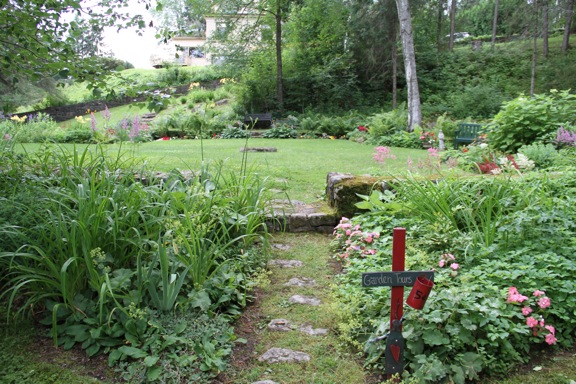AARCH Preservation Award winners include Hart, Luderowski

This garden is in the former site of the St. Eustace Episcopal Church in Lake Placid, located on the corner of Victor Herbert Road and Lake Street on property owned by Ruth Hart. The church was located there until 1927, when it was taken down and moved board by board to its present site on Main Street. The church opened on the new site on June 19, 1927. (News photo — Andy Flynn)
KEESEVILLE — Adirondack Architectural Heritage officials recently announced this year’s AARCH Preservation Award winners, recognizing exemplary historic preservation work throughout the Adirondack region, including sensitive restoration, rehabilitation, adaptive use, long-term stewardship, and individual achievement by a wide range of individuals and organizations.
In September, AARCH will honor the awardees below at its Preservation Awards ceremony. These seven recipients exemplify extraordinary stewardship or restoration of historic properties and individual achievements in preservation throughout the Adirondack region.
The recipients of the 2023 AARCH Preservation Awards are:
¯ Ruth Hart, Church Garden, for community revitalization and stewardship, Lake Placid, Essex County
The Church Garden is a garden around the original foundation of St. Eustace-By-The-Lakes, an Episcopal summer church in Lake Placid in the late 1800s and early 1900s. The church was dismantled and moved to its present location on Main Street in 1927.
In 1972, Dr. George Hart and his wife Ruth purchased the property where the original church stood. In tackling the new property and intending to garden there, Ruth discovered the foundation and continued her plan to maintain it as a garden. It is open to the public for visitation and has hosted weddings, baptisms, and other spiritual events.
¯ Nils Luderowski, architect, a posthumous award for lifetime achievement, town of Keene, Essex County
Luderowski was a friend and long-time member of AARCH. Over the years, he served as an AARCH Board and Advisory Council member, going above and beyond to support AARCH’s special events and fundraisers.
Luderowski pioneered the New Adirondack Style of architecture, a blend of Shingle, Craftsman, Prairie, and regional expressions, while maintaining an eye for modern living requirements and technology.
¯ The Tahawus Cultural Center, for ongoing rehabilitation and stewardship, AuSable Forks, Essex County.
The Tahawus Masonic Lodge 790 was chartered by the Masons on Oct. 11, 1884. The building was constructed in 1911 and designed by architect C. F. Kingsley of Keeseville, a former resident of AuSable Forks. It was one of the few buildings to survive the 1925 fire that destroyed most of the town. Over the years, the building has housed various businesses and organizations, such as a laundromat, the Adirondack Record newspaper, and the post office. In 2009, the building was acquired by Appleby Foundation, Inc. The renamed Tahawus Cultural Center began its transformation into the current space for dance, art, music and community engagement.
¯ The Bloom Cottage, Nancy and Robert Fierer, for restoration, Loon Lake, Franklin County
The Bloom, built in 1920, is one of 53 original cottages of the historic Loon Lake House and Resort. The Loon Lake House was built on the south and east shores of Loon Lake, about 15 miles northeast of Saranac Lake, by Ferdinand W. Chase and his wife, Mary. Mary Chase leased land to guests who wished to build their own cottages, stipulating that they contained no cooking facilities: guests were required to use the hotel for meals.
The Bloom Cottage had been abandoned for over a decade before the new owners undertook a complete renovation and restoration.
¯ Schroon Lake Community Church, for community revitalization, Schroon Lake, Essex County
The historic church in the heart of downtown Schroon Lake suffered a catastrophic fire in 2019. The original church, built more than 150 years ago, dominated the heart of downtown Schroon Lake. It was a traditional simple white church with a steeple that played the chimes at noon.
From the ashes, the community immediately launched a rebuilding effort with a goal not only to better serve the community needs but to preserve the identity of the downtown historically and culturally.
¯ Trustees of Hillview Free Library, for the restoration and stewardship of the Hillview Free Library, Diamond Point, Warren County
The Hillview Free Library was established in 1899 when Jane Keyes Hamilton, a New York City resident and visitor to Diamond Point, decided that the community should have a library. She, along with some like-minded residents, purchased the property and moved a nearby 1860s schoolhouse to the site. The building was refurbished and transformed into a library.
In 1901, the community outgrew the original building. Hamilton’s friend, architect J. Dickinson Hunter, designed the stunning stone-arched addition that opens into an oak-lined great room.
Over the years the Board of Trustees has committed itself to maintaining the library’s physical structure while also adding modern comforts, in keeping with Hillview’s distinctive place in the local community.
¯ Paul Besignano, for the rehabilitation and revitalization of War Cannon Spirits, Crown Point, Essex County
Now a tasting room at War Cannon Spirits, the space functioned as a mill when Putnam Creek was dammed and a pond existed behind the site. There were many alterations and additions over the last 200 years, yet the core structure remains one of the oldest of its kind.
War Cannon Spirits acquired the site in 2016. The owner spent over seven years restoring the mill to a respectful version of its original architectural vernacular.
The 2023 Preservation Awards will be presented on Sept. 22 at the Hitching Post in Lake Luzerne. To purchase tickets, visit aarch.org.



